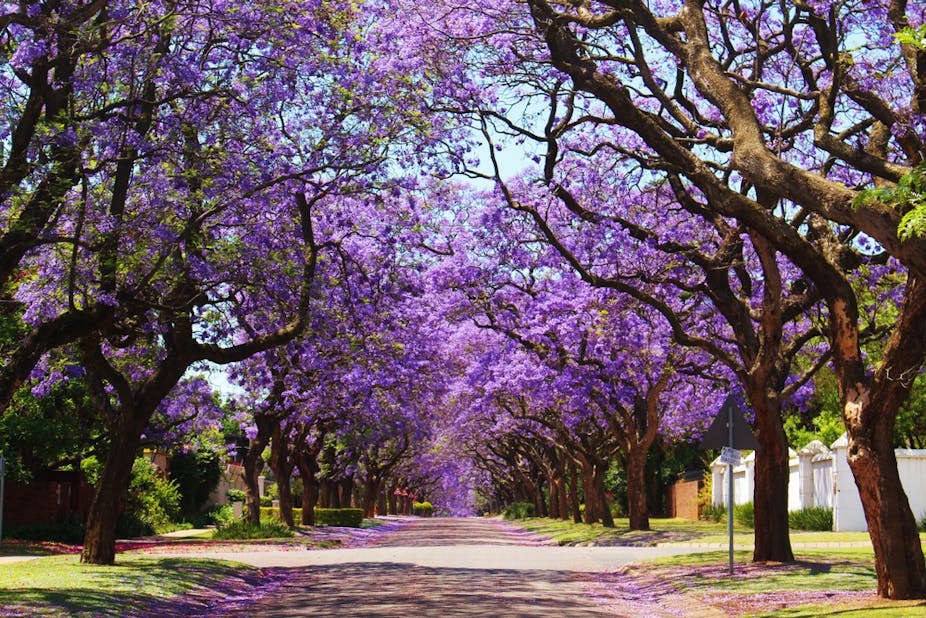In September each year, South Africa’s Gauteng province turns purple. The cities of Johannesburg and Pretoria are well covered with trees – and jacarandas (Jacaranda mimosifolia), with their purple blooms in late spring, are a prominent part of this urban forest.
About 16% of the land in the Gauteng City Region is planted with trees, forming one of the world’s largest and most densely vegetated man-made urban forests. Johannesburg alone is recorded to have over 10 million trees. Jacarandas were introduced to Pretoria and later Johannesburg in the early 1800s, specifically as ornamentals to line the streets of the suburbs and central business districts.
Octogenarian residents who have lived in Gauteng their whole life might remember that jacarandas did not always flower in September. In the 1920s and 1930s, the trees only started to bloom in mid-November. Gradually over the decades, the date of bloom has advanced through October to the early weeks of September. This is referred to as a phenological shift, and is being observed across a range of species globally as a result of climate change.
Read more: Explainer: why phenology is key in tracking climate change
The most notable example is the Japanese cherry blossoms. Not only are the cherry blossoms a key tourist attraction, and the cherry festivals important cultural events, but this also represents the world’s longest phenological record. Phenological analyses show that current cherry blossoming is occurring earlier than any time in the last 1,200 years.
We explored this change in the timing of jacaranda blossom in our paper published in the Journal of Urban Forestry and Urban Greening. Phenological shifts are species and location specific – in some areas, and for some species, events are even being delayed as a result of specific climate drivers. There is very little phenological data for South Africa, and so very little phenological research has been conducted compared to the work in countries across Europe, Asia and North America.
Because jacaranda blossoms result in such a dramatic change in the urban landscape each year, they are often reported on in the news and, more recently, in social media posts.
We mined these sources to compile a list of flowering dates of jacaranda trees spanning 1927-2019. This record allowed us the chance to contribute to the global attempts at recording phenological shifts.
The records confirmed the advance in flowering dates, and from these we quantified a mean rate of advance of 2.1 days per decade.
We then explored the climatic drivers of this advance, by comparing the flowering dates to meteorological data from across Gauteng. The advance in flowering took place against a backdrop of warming temperatures, ranging from 0.1-0.2°C per decade for daily maximum temperatures and a more rapid 0.2-0.4°C per decade for daily minimum temperatures. Rainfall changes during this time were less uniform.
If plants flower too early in the year, they are at risk of frost damage during the late winter months, and often do not complete their dormancy. Therefore, although phenological shifts represent an adaptation in plants and animals, these advances in flowering dates cannot continue indefinitely. At a critical threshold, the flowering season will become unsuccessful.
Understanding the role of climate
While phenological shifts are highly species and location specific, the broad climate drivers are well understood. Spring blossoms are triggered, in most cases, by temperatures warming above a certain threshold, following the completion of a dormant period. That dormant period often requires a certain number of days below a threshold temperature, or an accumulation of chilling units.
For some plants, the onset of rainfall is also important in triggering blossoms. While factors such as soil moisture, temperature and composition, sunshine hours, and the health of the tree can affect the mean flowering date, the shifts in flowering are driven by climate. The biometeorological science of phenology has developed over the past five decades, with methodologies to determine the climate drivers responsible for phenological shifts.
The strongest climatic driver of the phenological advance of jacaranda blossoms in the Gauteng city region was found to be daily maximum temperatures during the month of June – falling within the dormant period of the tree. This is not uncommon, as the dormant period is critical for resource management in the tree. It does mean that by the time the spring months of September and October come around, day to day temperature and rainfall will have less impact on when the trees flower. Over the period 1918-2019, June mean maximum daily temperatures have increased by 0.2°C a decade, while mean minimum daily temperatures have increased by 0.2-0.5°C a decade.
Jacarandas occupy a peculiar position in South Africa: they are well loved and noticeable trees but they are invasive aliens. Due to their status as invasive species, replanting of jacarandas is currently prohibited, although the species has certain urban areas in which restrictions are less strict. This means the population of trees is ageing. The trees can live for over 100 years, but for some of the original trees, their centenary has already passed.
Phenological shifts represent an adaptation strategy for the plant – they cannot move on their own to a cooler climate that more closely matches what they are traditionally accustomed to, and so they alter their annually recurrent biological events. This cannot happen indefinitely, and as temperatures continue to increase, a more general risk of heat stress to the tree is heightened. This could mean that the years of purple spring seasons in Gauteng are limited.
The rate, direction, and climatic drivers of phenological shifts are specific to individual species. Therefore, we cannot extrapolate these results to all flowering trees in Gauteng, or even to all invasive species in the city-region. However, the results of this study do provide a warning for the urban forest, and an urgent call for future research. Collating data from a range of sources, including traditional and social media, can contribute to better understanding and modelling these changes.

